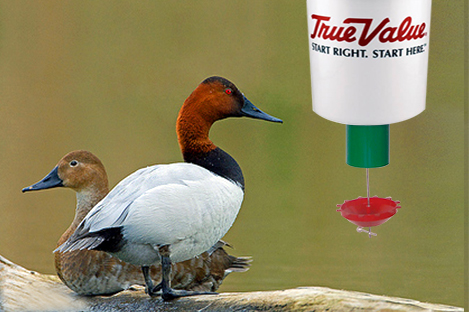
The largest diving duck found in North America is the canvasback duck. It is distinguished from other ducks by its sloping profile. The drake has a black bill, a chestnut red head and neck, a black breast, a grayish back, black rump, and a blackish brown tail and its sides, back, and belly are white with fine vermiculation which looks like the weave of a canvas. The iris is bright red in the spring, but dulls with the onset of winter. The hen has a black bill, a light brown head and neck, which becomes darker brown chest and fore back. The sides, flanks, and back are grayish brown. For both the drake and the hen, the bill is almost black and the legs and feet are bluish-gray.
The PECk-O-MATIC Automatic Duck Feeder provides fresh feed at all times. Fresh feed is among the most essential aspects of breeding healthy poultry. To feed corn, the suitable size of the regulator disc is ¾ inch or 1inch. When the feed is crumble or milo, the 3/8-inch regulator disc from PECk-O-MATIC Automatic Duck Feeder can be used.
The canvasback habitat is in prairie potholes. The nest it builds is bulky and made from vegetation found in marshes and lined with down. The canvasback feeds on seeds, buds, leaves, tubers, roots, snails, and insect larvae. The staple diet besides the wild celery is the tubers of sago pondweed. The canvasback mostly dives for its food but it dabbles occasionally. The canvasback has large webbed feet adapted for diving and its bill helps it dig tubers from the substrate. In the late 1930s, studies showed that four-fifths of the food eaten by canvasbacks was plant material.
Valisineria is the name of this species and it is derived from the plant Americana. The winter buds and rhizomes of this plant are the canvasback's preferred food during the nonbreeding period. Early European inhabitants of North America's felt that that the back of this breed was the color of canvas and hence they named it Canvasback. In French, it is called morillon à dos blanc, in Spanish, pato lomo blanco and in Mexico, it is called pato coacoxtle.